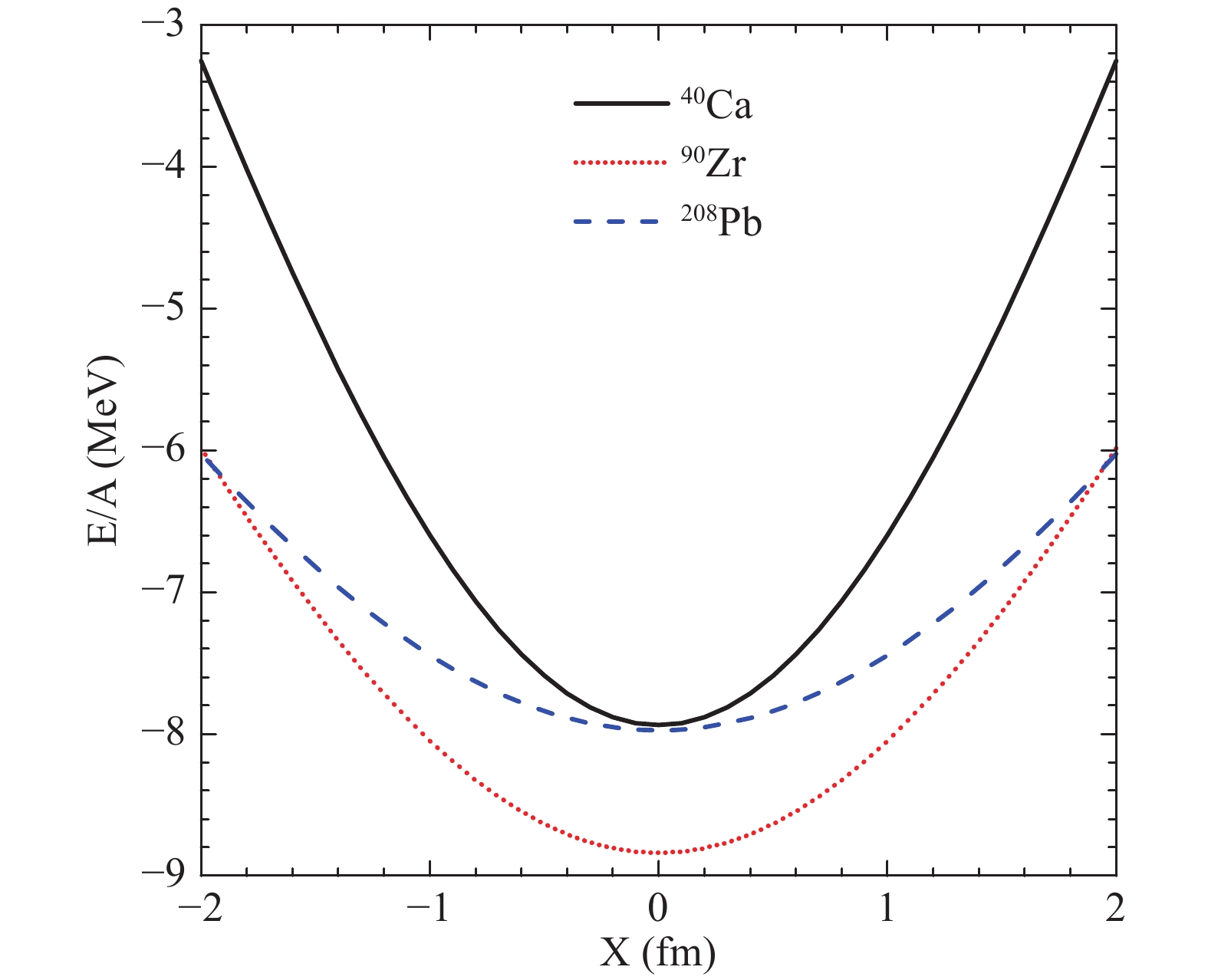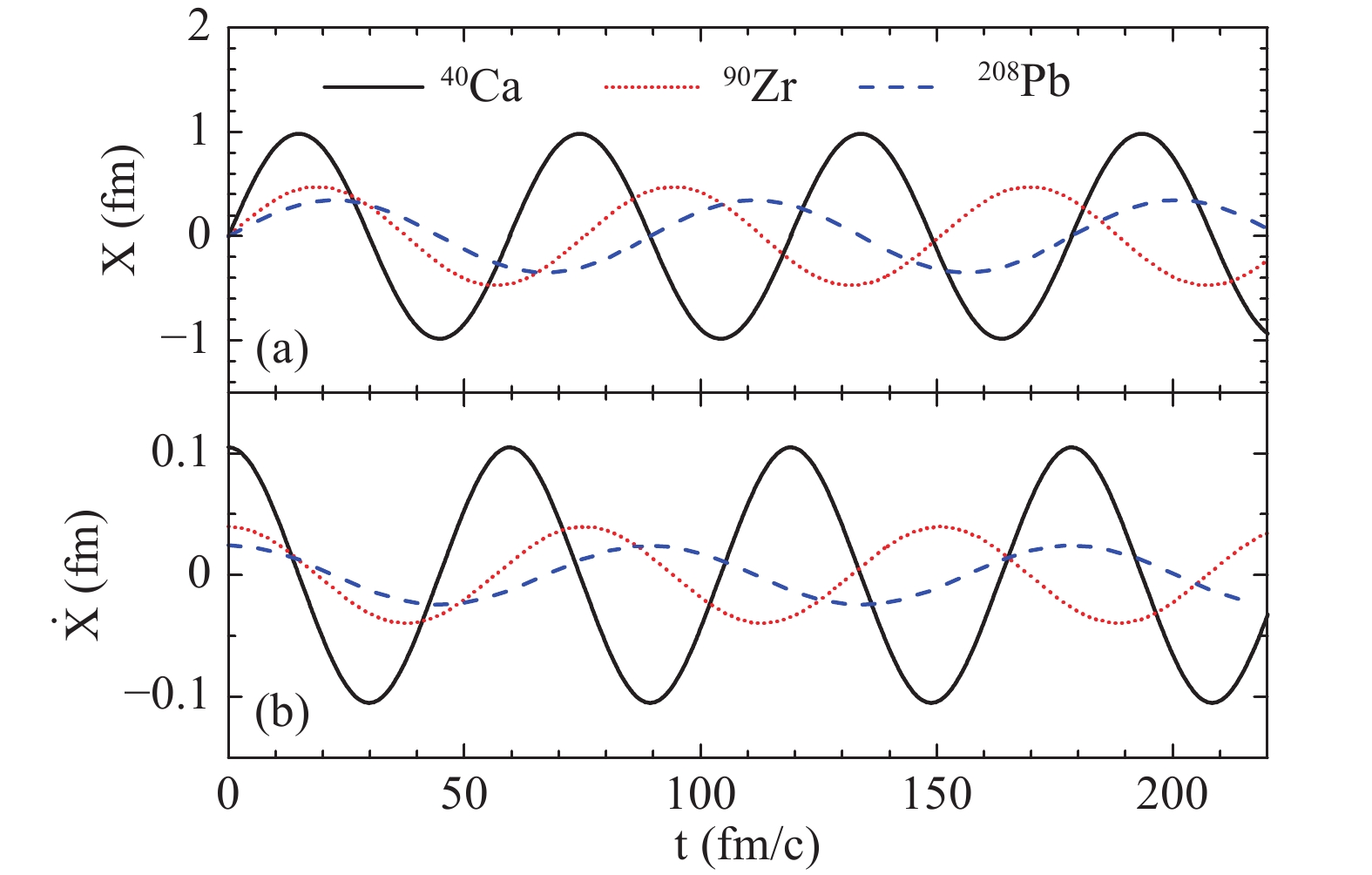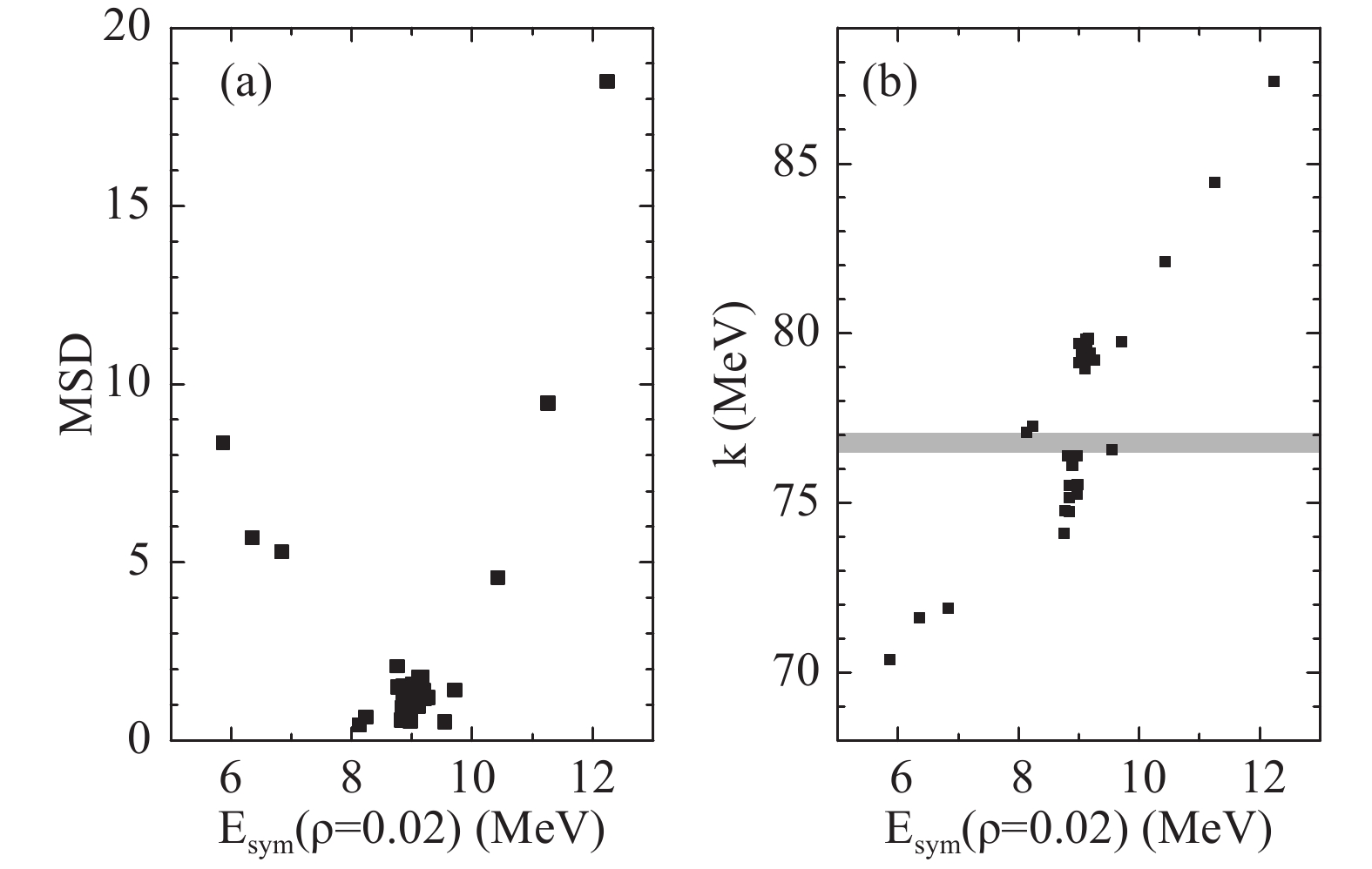HTML
--> --> -->Because of its proven measurement technique and strong relation to the microscopic structure of the nuclei, the IVGDR has been employed as an excellent probe for determination of nuclear properties, such as the fission hindrance [8], nuclear deformation at finite excitation [9], clustering configurations [10], isospin mixing at high temperature [11], and shear viscosity to entropy density ratio [12]. The relationship between the symmetry energy and the IVGDR has been efficiently described by some models, such as the hydrodynamical model [13], isospin-dependent quantum molecular dynamics model [14], and isospin-dependent Boltzmann-Uehling-Uhlenbeck model [15]. The experimental value of the IVGDR, such as in 208Pb, has been used as a constraint on the symmetry energy at subnormal densities [16].
The symmetry energy is defined by the parabolic approximation of the total energy per nucleon of the isospin asymmetry nuclear matter,
In this study, we attempt to constrain the symmetry energy at the subnormal density by the IVGDR data of the spherical nuclei. This idea is not new, but in the present work we develop it based on the global IVGDR data and a new theoretical framework. In the recent publication [26], the updated experimental data and corresponding uncertainties of IVGDR energies are presented. We use these global data, rather than only the data of one or several nuclei. Moreover, we use the theoretical framework based on the Skyrme energy-density functional and the Langevin equation, which has been successfully applied to study the isoscalar giant monopole resonances (ISGMR) in our previous work [27]. The paper is organized as follows. In Sec. 2, we describe the method. In Sec. 3, we present both the results and discussions. Finally, the summaries are given in Sec. 4.
$M\ddot X + \frac{{\partial V}}{{\partial X}} = D(t) + \delta F(t),$ | (1) |
$\begin{split}V =& {V_0} + {V_3} + {V_{\rm eff}} + {V_{\rm fin}} + {V_{\rm so}} + {V_{\rm sg}}\\ =& \int {{\rm d^3}} {{r}}({\varepsilon _0} + {\varepsilon _3} + {\varepsilon _{\rm eff}} + {\varepsilon _{\rm fin}} + {\varepsilon _{\rm so}} + {\varepsilon _{\rm sg}}),\\{\varepsilon _0} =& \frac{{{t_0}}}{2}\left(1 + \frac{{{x_0}}}{2}\right){\rho ^2} - \frac{{{t_0}}}{2}\left({x_0} + \frac{1}{2}\right)\left(\rho _n^2 + \rho _p^2\right),\\{\varepsilon _3} = &\frac{{{t_3}}}{{12}}\left(1 + \frac{{{x_3}}}{2}\right){\rho ^{\sigma + 2}} - \frac{{{t_3}}}{{12}}\left({x_3} + \frac{1}{2}\right){\rho ^\sigma }\left(\rho _n^2 + \rho _p^2\right),\\\end{split}$ |
$\begin{split}{\varepsilon _{\rm eff}} =& \frac{1}{4}\left[{t_1}\left(1 + \frac{{{x_1}}}{2}\right) + {t_2}\left(1 + \frac{{{x_2}}}{2}\right)\right]\rho ({\tau _n} + {\tau _p})\\ &+ \frac{1}{4}\left[{t_2}\left({x_2} + \frac{1}{2}\right) - {t_1}\left({x_1} + \frac{1}{2}\right)\right]({\rho _n}{\tau _n} + {\rho _p}{\tau _p}),\\{\varepsilon _{\rm fin}} =& \frac{1}{{16}}\left[3{t_1}\left(1 + \frac{{{x_1}}}{2}\right) - {t_2}\left(1 + \frac{{{x_2}}}{2}\right)\right]{(\nabla \rho )^2}\\ &- \frac{1}{{16}}\left[3{t_1}\left({x_1} + \frac{1}{2}\right) + {t_2}\left({x_2} + \frac{1}{2}\right)\right]\left[{\left(\nabla {\rho _n}\right)^2} + {\left(\nabla {\rho _p}\right)^2}\right],\\{\varepsilon _{\rm so}} =& \frac{1}{2}{W_0}[{{J}} \cdot \nabla \rho + {{{J}}_n} \cdot \nabla {\rho _n} + {{{J}}_p} \cdot \nabla {\rho _p}],\\{\varepsilon _{\rm sg}} = & - \frac{1}{{16}}({t_1}{x_1} + {t_2}{x_2}){J^2} + \frac{1}{{16}}({t_1} - {t_2})(J_n^2 + J_p^2),\end{split}$ | (2) |
The density distribution of the static Hartree-Fock ground state is determined by the Skyrme Hartree-Fock-Bogolyubov (SHFB) model within the spherical symmetry, the code of which is given in Ref. [32].
Subsequently, the potential energy is calculated as a function of the collective variable X after separating the centers between the neutron and the proton densities. The results for 40Ca, 90Zr, and 208Pb are shown in Fig. 1. Because the Fermi kinetic energy is independent of the collective variable X, the potential energy and the energy per nucleon exhibit the same potential well. We observe the harmonic-oscillator-type potential well. The valley values represent binding energies of the nuclei, which will not affect the excitation energy of the IVGDR. The widths of the potential wells exhibit a mass dependence, which is the origin of the mass dependence of the IVGDR energy.
 Figure1. (color online) Energy per nucleon as a function of the collective variable X in the IVGDR of 40Ca, 90Zr, and 208Pb.
Figure1. (color online) Energy per nucleon as a function of the collective variable X in the IVGDR of 40Ca, 90Zr, and 208Pb.With the potential energy as a function of the collective variable X, the Langevin equation Eq. (1) can be solved self-consistently. The initial value X0 of the collective variable is zero. The initial velocity
${\dot X_0} = \sqrt {\frac{{2{E^*}}}{M}} .$ | (3) |
Figure 2 shows the solution of the Langevin equation for 40Ca, 90Zr, and 208Pb nuclei. In the calculation, the BSk9 functional is applied. The solutions exhibit a good oscillation structure. Due to the narrowest potential well, the period for the 40Ca nucleus is the shortest. With the Fourier transform, one obtains the excitation energy 18.44 MeV from the period value 59.8 fm/c. Compared with the data 20.14 ± 1.01 [33], the excitation energy is smaller by 8.4%. The period for the 90Zr nucleus is 75.4 fm/c, resulting in
 Figure2. (color online) Solutions of Eq. (1), shown as (a) the collective variable X and (b) the velocity
Figure2. (color online) Solutions of Eq. (1), shown as (a) the collective variable X and (b) the velocity  Figure3. (color online) Excitation energies of the IVGDR as a function of the mass number for spherical nuclei. In the calculation, the functionals Skz4, BSk9, and SkMP are applied, consecutively. The solid line shows the fit by the A-1/3 law. Experimental data are obtained from Ref. [26].
Figure3. (color online) Excitation energies of the IVGDR as a function of the mass number for spherical nuclei. In the calculation, the functionals Skz4, BSk9, and SkMP are applied, consecutively. The solid line shows the fit by the A-1/3 law. Experimental data are obtained from Ref. [26].Figure 2 shows that the amplitudes of the IVGDR are 0.98, 0.47, and 0.35 fm for 40Ca, 90Zr, and 208Pb respectively. This means that only the skins of the neutrons and protons, in which the density is in the subnormal region, are separated in the resonances. Figure 4(a) shows the density distribution of the static Hartree-Fock ground state of 40Ca, 90Zr, and 208Pb nuclei. The thicknesses of the skins are less than 2 fm, which is less than the amplitudes of the IVGDR. Figure 4(b) shows the difference of the isospin asymmetry between the ground state and the IVGDR state for X = 0.1, 0.2, 0.3, and 0.4 fm. Only the isospin asymmetry in the skin exhibits a great change in the IVGDR. Moreover, the cures have peaks near 0.02 fm?3. The symmetry energy at density 0.02 fm?3 indicates the highest contribution to the potential well.
 Figure4. (color online) (a) Density distribution of the static Hartree-Fock ground state of 40Ca, 90Zr, and 208Pb nuclei. (b) Difference of the isospin asymmetry between the ground state and the IVGDR state for the collective variable X = 0.1, 0.2, 0.3, and 0.4 fm. The amplitude increases from X = 0.1 fm to 0.4 fm, which is marked for 40Ca.
Figure4. (color online) (a) Density distribution of the static Hartree-Fock ground state of 40Ca, 90Zr, and 208Pb nuclei. (b) Difference of the isospin asymmetry between the ground state and the IVGDR state for the collective variable X = 0.1, 0.2, 0.3, and 0.4 fm. The amplitude increases from X = 0.1 fm to 0.4 fm, which is marked for 40Ca.We use two observables to describe the agreement of the calculations to the data. One is the mean square deviation (MSD), and the other is the scale parameter. The MSD is defined as,
${\rm MSD} = \frac{1}{N}\sum\limits_i^N {\frac{{{{(E_{{\rm cal},i}^* - E_{{\rm exp},i}^*)}^2}}}{{\sigma _{{\rm exp},i}^2}}} ,$ | (4) |
 Figure5. (a) Mean square deviation of the calculation compared with the data, and (b) scale parameter, shown as a function of the symmetry energy at density 0.02 fm?3 provided by the Skyrme functionals.
Figure5. (a) Mean square deviation of the calculation compared with the data, and (b) scale parameter, shown as a function of the symmetry energy at density 0.02 fm?3 provided by the Skyrme functionals.The IVGDR energy decreases with increasing mass, which can be described by the scale law kA?1/3. Fitting the data, we obtain k = 76.78 ± 0.28. For the calculations, the scale parameters increase linearly with increasing symmetry energy at a density 0.02 fm?3, as shown in Fig. 5(b). The scale parameters for the functionals MSk2 and SLy230a denote the upper and lower limits of the data range, respectively. The symmetry energy at the density of 0.02 fm?3 is in the region 8.13 MeV to 9.54 MeV. Many studies dealt with the symmetry energy at subnormal densities, as described in the review articles Ref. [24]. At the density of 0.02 fm?3, the symmetry energy from 6.4 MeV to 8.2 MeV is recommend by the best fitted to the masses of double magic nuclei [35]. This recommended region is slightly smaller than our suggested region, although they overlap. Another symmetry energy of 8.8 MeV, suggested by the chiral effective field calculations, is in the center of our suggested region [36].
